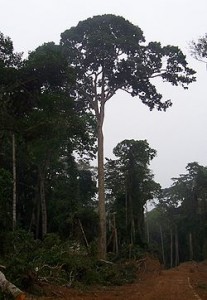A substantial specimen, even in the jungles of the Congo.
Common trade names: Gold Coast cedar, Assie sapelli, Lifari, Sapele mahogany, Scented mahogany, West African Cedar
Genus: Entandrophragma cylindricum
Janka Hardness (pounds-force): 1480
Description: Red to purplish brown, medium to dark. Color will darken over time. Figuring is a prominent feature of Sapele, and there is a wide variety of patterns that occur in this species. Grain is generally wavy and interlocked. Moderately to very durable to rot. Some insects will get after Sapele.
Location: Central Africa, namely: Angola, Cameroon, Congo, Ghana, Ivory Coast, Nigeria, Zaire, Uganda, Togo, Central African Republic, Gabon.
Common Aliases: Liboyo, Odupon, Penkwa, Tshimay noir, M’boyo
Performance: Tearout can occur more frequently than with most due to the interlocking nature of the grain. Furthermore, a chemical reaction resulting in staining may occur when put into direct contact with iron. Weird wood here.
Acclimation: For air drying, simply allow a half-inch or so among parallel planks stacked and spaced by level. It’s that easy, and in two or so weeks’ time, the lumber is ready for installation in your climate!
Common Uses: Musical instruments, furniture, boatbuilding, turnings, knick-knacks, veneers, plywood.
From: The Wood Database
Common Name(s): Sapele
Scientific Name: Entandrophragma cylindricum
Distribution: Africa
Tree Size: 100-150 ft (30-45 m) tall, 3-5 ft (1-1.5 m) trunk diameter
Average Dried Weight: 45 lbs/ft3 (715 kg/m3)
Basic Specific Gravity: .55
Hardness: 1,480 lbf (6,580 N)
Rupture Strength: 16,030 lbf/in2 (110,550 kPa)
Elastic Strength: 1,700,000 lbf/in2 (11,720 MPa)
Crushing Strength: 8,700 lbf/in2 (60.0 MPa)
Shrinkage: Radial: 4.6%, Tangential: 7.4%, Volumetric: 14.0%, T/R Ratio: 1.6
